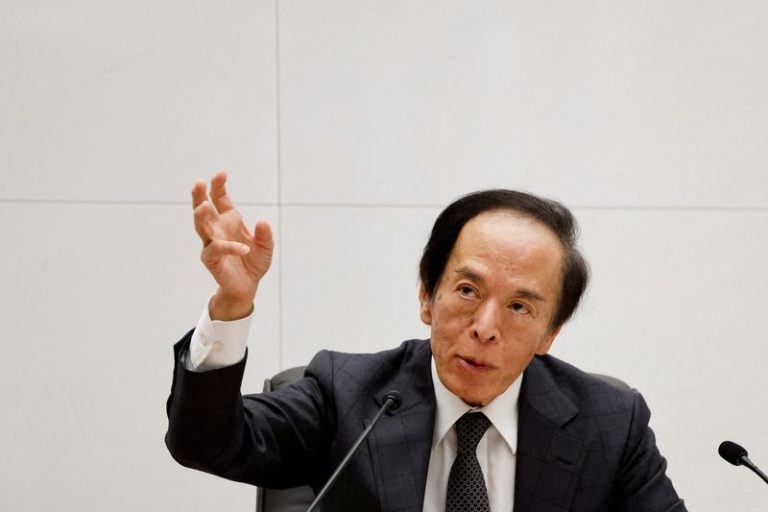By Leika Kihara
(Reuters) -The Bank of Japan holds its first policy meeting of the year next week and the outcome will be announced days after the inauguration of U.S. President-elect Donald Trump.
Here is a guide on what to expect and why the BOJ’s rate review matters:
WHEN DOES THE BOJ MEETING TAKE PLACE?
The BOJ board that sets monetary policy is due to meet on Jan. 23-24. It will announce its decisions at the end of its deliberations.
The BOJ ended years of negative interest rates in March and raised its short-term policy target to 0.25% in July. It has signalled a readiness to hike again if wages and prices move as projected.
IS THE BOJ GOING TO RAISE INTEREST RATES?
There is growing conviction within the BOJ that conditions for another increase are coming into place. The economy continues to expand moderately and inflation has held above its 2% target for nearly three years.
Companies continue to pass on rising raw material and labour costs to buyers, suggesting the BOJ board is likely to revise up its inflation forecasts in a quarterly outlook report due next week.
More importantly, there have been increasing signs that firms will offer bumper pay hikes for a third straight year in annual wage negotiations with unions kicking off in March.
The BOJ’s regional branch managers said wage hikes are spreading to companies of all sizes and sectors, meeting a key prerequisite for raising interest rates.
As such, the central bank is likely to raise rates to 0.5% next week, barring a Trump-induced market shock.
WHAT HAVE BOJ POLICYMAKERS SAID SO FAR?
The BOJ’s views on wages and the U.S. policy outlook have been closely watched by markets, after Governor Kazuo Ueda cited uncertainty over the domestic wage outlook and Trump’s policies as reasons to hold off raising rates last month.
In a speech on Tuesday, Deputy Governor Ryozo Himino said wage growth will likely remain strong this year. A day later, Ueda echoed the optimism in a sign of the BOJ’s conviction that Japan was progressing towards durably hitting its inflation target.
Both Himino and Ueda said the BOJ will debate whether to raise rates next week, indicating a strong chance of a hike.
WHAT COULD HOLD POLICYMAKERS BACK?
With increased prospects of sustained wage gains, the only remaining hurdle for raising rates next week would be the risk of Trump dropping a bombshell and upending financial markets.
Aside from his inaugural speech, Trump is expected to issue a number of executive orders when he begins his second term in the White House on Monday.
Deputy governor Himino said he would look for clues on the “balance and schedule” of the new president’s policy steps, as well as anything that had not been flagged by Trump so far.
If Trump’s comments shock markets and cause a plunge in global stocks, the BOJ may prefer to stand pat until markets have priced in the news.
HOW COULD MARKETS REACT TO A JAPAN RATE INCREASE?
Receding bets of further rate cuts by the U.S. Federal Reserve mean the U.S.-Japan interest rate differential will remain wide, keeping the yen under downward pressure.
A rate hike by the BOJ will likely nudge up the yen. But the currency’s gains may be short-lived unless Ueda delivers hawkish comments on the outlook in his post-meeting news briefing.
WHAT ELSE SHOULD MARKETS LOOK OUT FOR?
The BOJ will release a quarterly outlook report with revised growth and inflation forecasts, which will show how optimistic the board is on Japan’s prospects for sustainably hitting 2% inflation. That will affect the pace of future rate increases.
Ueda may also give clues on the timing and pace of further hikes at his post-meeting briefing.
The key would be the governor’s view on Japan’s neutral rate. BOJ staff estimates show the inflation-adjusted real neutral rate to be in a range of around -1% to +0.5%. That means if inflation were to hit the BOJ’s 2% target, it could raise its short-term rate at least to around 1% without cooling growth.
Based on forecasts in October, the BOJ expects short-term rates to approach what it considers neutral “in the latter half of the three-year projection period” through March 2027, which suggests some time after October 2025.
While hawkish board member Naoki Tamura projects the neutral rate to be around 1%, Ueda has said it was too hard to come up with credible estimates due to a lack of data.
WHAT’S NEXT?
Many analysts expect the BOJ to keep raising rates at a pace of roughly twice a year. If the BOJ increased rates next week, it may stay in a holding pattern until the latter half of this year when there is more clarity on the impact of Trump’s policies.
Domestic politics also complicate the BOJ’s rate-hike timing with an upper house election slated for July, where Prime Minister Shigeru Ishiba’s minority coalition could struggle to garner votes. The BOJ may prefer to avoid shifting policy until the political dust settles.

